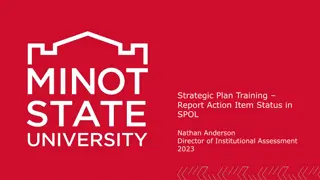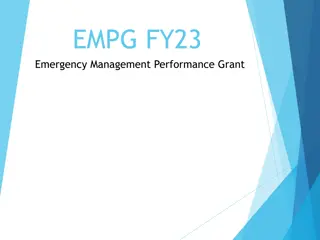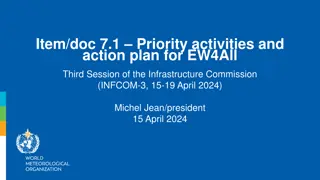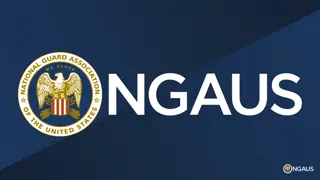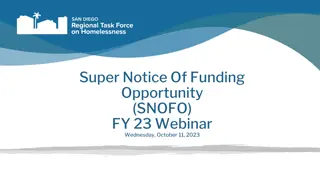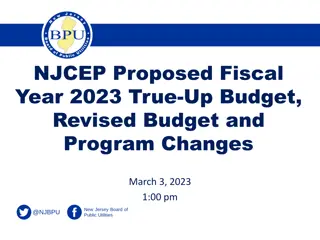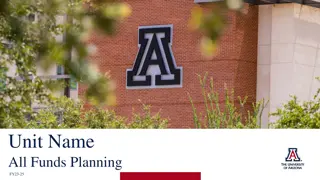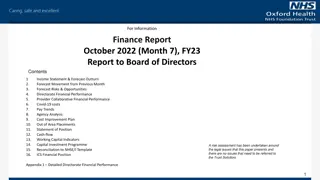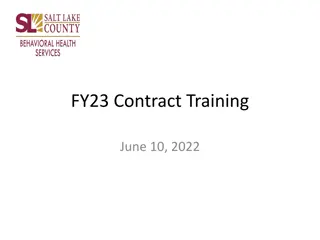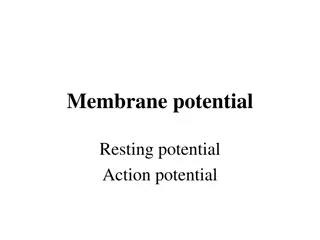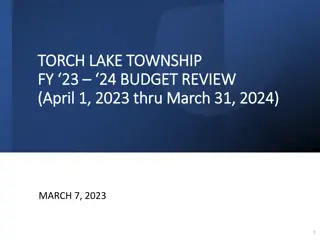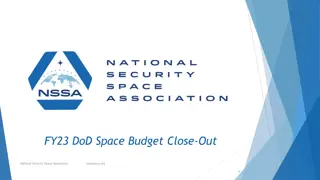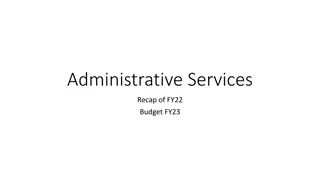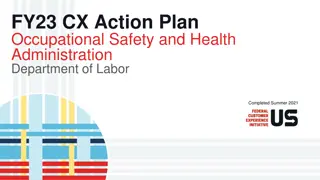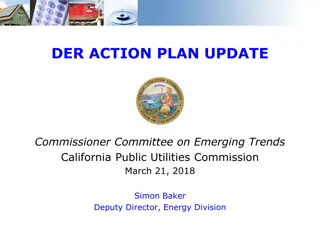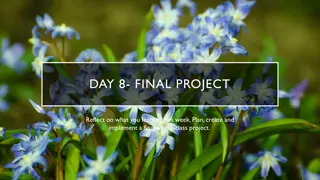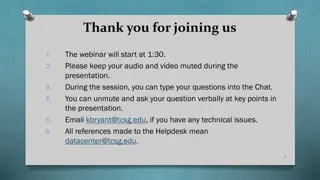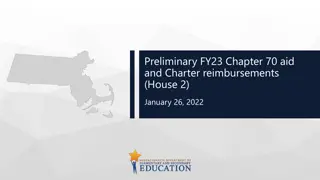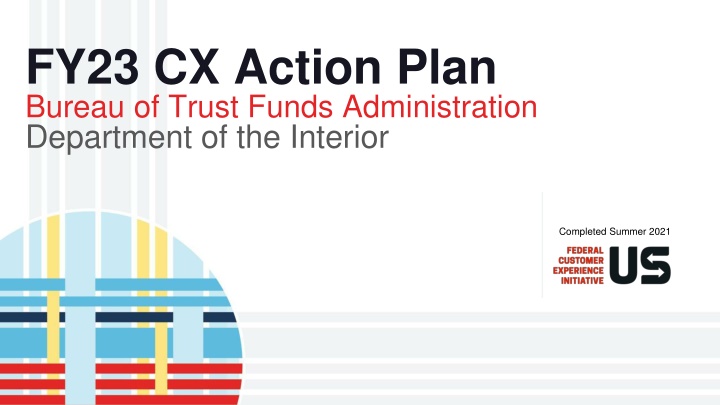
FY23 CX Action Plan
The Bureau of Trust Fund Administration (BTFA) has significantly improved its Customer Experience (CX) maturity under strong leadership, focusing on enhancing services for Indian trust beneficiaries. Initiatives include setting up a Governance Committee, developing interactive kiosks for underserved Native American communities, and launching a Welcome/Notification Letter service for new Individual Indian Monies (IIM) accountholders.
Download Presentation

Please find below an Image/Link to download the presentation.
The content on the website is provided AS IS for your information and personal use only. It may not be sold, licensed, or shared on other websites without obtaining consent from the author. If you encounter any issues during the download, it is possible that the publisher has removed the file from their server.
You are allowed to download the files provided on this website for personal or commercial use, subject to the condition that they are used lawfully. All files are the property of their respective owners.
The content on the website is provided AS IS for your information and personal use only. It may not be sold, licensed, or shared on other websites without obtaining consent from the author.
E N D
Presentation Transcript
FY23 CX Action Plan Bureau of Trust Funds Administration Department of the Interior Completed Summer 2021
FY21 Capacity Assessment Reflection Summary What we re proud of this year: During 2020 and 2021 BTFA s CX Maturity increased under the Leadership and Customer Understanding CX management areas. Leadership buy-in/improvement includes: The Director - BTFA, provides the budget and authority to improve the beneficiary experience. In addition, the Director has assembled a Governance Committee and the Beneficiary Service Council to assist with reviewing and prioritizing decisions which impact the beneficiary experience. The Director -BTFA understands the importance of developing a beneficiary centered culture at BTFA and is expecting to achieve this state after the tasks/elements in the Beneficiary Services section of the BTFA Strategic Plan 2021-2025 are completed. BTFA's goal is to build an even stronger CX community of practice, with a shared purpose, where all staff take ownership in the delivery of consistent services so that the beneficiary has a positive government experience. The Director-BTFA becoming more engaged with improving services and delivering new services to our Indian trust beneficiaries and an understanding that service delivery improvements can drive mission success. The engagement of the Director-BTFA resulted in a noticeable increase in senior leadership's understanding of beneficiary needs as well as participation in the identification and implementation of new services. For example: With the realization that providing services to all Indian trust beneficiaries is a critical component of the BTFA mission, leadership addressed the need to provide services to some underserved Native American communities, on remote reservations, where in-person service is not available and telephone and mobile channels simply won t work. To address this gap, BTFA is currently developing prototype interactive kiosks so that these Indian trust beneficiaries will not be excluded from government services simply because they are unable to access in-person or mobile digital service channels. This new beneficiary service channel offers beneficiaries living in underserved Native American communities, the opportunity to have a face to-face interaction with the government. 2
FY21 Capacity Assessment Reflection Summary (cont.) What we re proud of this year: Customer Experience improvements include: With an improved understanding of beneficiary expectations and what matters to them, leadership has prioritized an overall strategic decision to ensure that our Indian trust beneficiaries are able to easily interact with the government and not be excluded from services, for any reason. Using a customer focused approach to the implementation of new services, feedback from beneficiaries became a critical part of BTFA's effort to deploy kiosks as a new service delivery channel. Qualitative information was collected from beneficiaries on their needs and their ideas of what the kiosk user experience should include. This information is now being used to develop the kiosk prototype software. Analysis of our initial Journey Mapping results indicated that some beneficiaries were not familiar with BTFA or could not recall how they learned that they had an Individual Indian Monies (IIM) account. Therefore, in March 2021 BTFA launched a new beneficiary service which sends a Welcome/Notification Letter to new IIM accountholders advising that an IIM account has been established for them because they have an interest in trust or restricted land and/or funds. The letter clarifies that the account is managed by the Department of the Interior, Bureau of Trust Fund Administration (BTFA) and provides instructions on how to contact BTFA with questions, or requests for service. Annually, BTFA opens approximately 7,200 new IIM accounts. Since March, 2021 the Trust Beneficiary Call Center has responded to 130 inquiries from new accountholders thus, providing an opportunity for the new beneficiary to start building a relationship with BTFA. Publication of IIM Welcome Guide on BTFA public facing website. Note: At this time BTFA has neither quantitative or qualitative data available to measure the improvements identified above. Part of the reason for this lack of information is due to the fact that BTFA suspended all surveys and qualitative information collection efforts, between March 2020 and March 2021, because we did not wish to burden our Indian trust beneficiaries during the pandemic. 3 Where we need to do better: CX Management Area Measurement. The need for collection of beneficiary feedback over multiple channels. Transactional after contact surveys are only collected for beneficiary contacts made at the Trust Beneficiary Call Center touchpoint. Therefore, BTFA has a need to collect beneficiary feedback at current and future touchpoints i.e., Agency locations, public facing website, and kiosks. The collection of feedback at all touchpoints is expected to provide BTFA with additional end to end information for improving the beneficiary journey. A comprehensive enterprise wide Voice of the Customer (VOC) strategy has been identified as an action item in the Beneficiary Services section of the BTFA Strategic Plan 2021-2025 BTFA Strategic Plan.
Adapting Service During a Global Pandemic Where we innovated Virtual Outreach Events: BTFA Trust Operations Field - Agency staff are cognizant that the "face-to-face" service that they provide to beneficiaries at reservation locations actually builds trust in the services delivered by the government. Unfortunately, the pandemic shifted contact/engagement away from the "face-to-face" delivery of services at BTFA Agency locations. This change required beneficiaries to make virtual contact with Agency staff, who were working remotely, or the Trust Beneficiary Call Center. In order to continue face-to-face engagement with beneficiaries during the pandemic, the BTFA Trust Operations Field, Fort Berthold Agency initiated Virtual Outreach sessions. The virtual sessions covered relevant topics such as: a.) How to Read Your IIM Quarterly Statement and b.) Understanding fractional owner interests. In addition, the virtual sessions focused on Financial Literacy training. Benefits: Virtual Outreach events allowed BTFA to reach individual Indian beneficiaries who might not otherwise be in contact with BTFA or DOI. The Virtual Outreach sessions were an educational opportunity that allowed BTFA beneficiaries to continue engagement. The financial literacy curriculum empowers Indian Country - with financial skills. Goals: Along with in-person outreach sessions, the Virtual Outreach sessions will remain in-play as a BTFA engagement/communication channel. BTFA outreach sessions will serve as an opportunity to build the beneficiary/trustee relationship by providing information on: services, trust asset management and trust initiatives. Outreach events will provide a consistent financial literacy curriculum for BTFA beneficiaries. 4 During FY 22 BTFA will: Participate in the Financial Literacy and Education Commission (FLEC). Engage with beneficiaries in 20 plus BTFA Virtual Outreach events; reaching over 1,200 individual Indian beneficiaries who might not otherwise be in contact with DOI.
HISP Equity Reflection Who is this provider intended to serve? The mission of the BTFA is to manage the trust beneficiaries financial assets. BTFA supports the Secretary of the Department of the Interior to fulfill their trust responsibilities by providing fiduciary guidance, management, and leadership for Tribal Trust and Individual Indian Money (IIM) accounts. We disburse more than $1 billion annually and have almost $6 billion under active day-to-day management and investment on behalf of Tribes and individuals. Currently, BTFA maintains approximately 3,800 accounts for 250 Tribal entities with assets exceeding $4.6 billion, and over 400,000 IIM accounts with assets of approximately $1.1 billion. This income is generated from the sale or rental of Indian-owned land and natural resources such as timber, and royalties from oil and natural gas exploration and production. Funds also are derived from interest earned on invested funds, as well as awards or settlements of tribal claims. Are there barriers that people of color, people with disabilities, LGBTQ+ people, women, non-native English speakers, and others who have been historically underserved, marginalized, discriminated, and adversely affected by persistent poverty and inequality face with regard to this program or service? How might these individuals interact with your program differently? The funds being managed by BTFA for individual Indian trust beneficiaries are not benefits; instead, they are proceeds from land/resources managed in trust by the Federal government. Therefore, BTFA s beneficiaries do not apply for or make claims regarding their monetary trust assets. In addition, BTFA is unique in that we don't have "customers," we have beneficiaries". Customers can seek where they want to receive services; however, the individual (IIM) beneficiaries must work with BTFA regarding their monetary trust assets. Therefore, working with BTFA generally requires direct beneficiary contact, (engagement), with a BTFA Agency office, or the Trust Beneficiary Call Center. (Note: most Agency offices are located on Indian Reservations). Communication can be in the form of telephone calls and in-person service; or correspondence via the US Postal Service mail. Alternatively, as long as BTFA has a current mailing address, attached to a beneficiary s Individual Indian Monies (IIM) account, a beneficiary does not have to make direct contact or communicate with BTFA. A current mailing address allows BTFA to mail a beneficiary their trust funds and quarterly performance statements, as required by law* (Note: funds can also be dispersed via Direct Deposit however; this would require direct contact or correspondence with BTFA). *The American Indian Trust Fund Management Reform Act of 1994 ( The Act ) sets the requirements for performance statements and requires that the beneficiary is sent a periodic statement of performance not later than 20 business days after the close of a calendar quarter. Despite BTFA's beneficiary centric approach to the delivery of trust services, BTFA does not have a current address for approximately 15% of the Indian trust beneficiaries. (Note: these IIM accounts are classified as Whereabouts Unknown (WAU)). BTFA cannot engage with these particular beneficiaries, nor issue quarterly performance statements, as required by law, because we do not have their current contact information. Consequently, these beneficiaries are not engaging with BTFA either and are, therefore, unable to receive their funds and quarterly performance statements. 5
HISP Equity Reflection (cont.) The lack of engagement is compounded further, for this universe of beneficiaries, by the following burdens or barriers: Learning about BTFA s existence: Some individuals are unaware that they are Indian trust beneficiaries and that direct contact, a current address, is an integral part of BTFA s service delivery. The fact that some individuals do not realize or know that they are trust beneficiaries and can engage with BTFA may be attributable to: an IIM account being set up without a valid address, or no address; minimal communication, or lack of communication, from BTFA; unfamiliarity with the process of why an IIM account is established on their behalf; lack of knowledge about the mission of BTFA and Department of the Interior s (DOI) trust responsibilities; and how to engage with BTFA. Underserved Native American Communities: Unfortunately, misunderstandings may also be attributable to belonging to a universe of citizens characterized as being underserved, marginalized, and adversely affected by persistent poverty and inequality. Consequently, for some of the WAU beneficiaries that belong to this underserved population, engagement with BTFA could make an impact on their lives, especially if funds are available in their IIM accounts. (Note: WAU status IIM account balances range from < $1 to > $100,000. On the average, 45% of these accounts have a balance of less than $1 while 30% have balances under $100 and equal to or over $1). Specific barriers might include: Inability to afford a post office box; and Belonging to a highly mobile population segment. 6
HISP Equity Reflection (cont.) The lack of engagement is compounded further, for this universe of beneficiaries, by the following burdens or barriers: Logistical and Technological Exclusion: It is possible that some individuals who are unaware that they are Indian trust beneficiaries - may also be excluded from BTFA s services because they live on remote Indian reservations where they are unable to access in-person services; and/or telephone and mobile channels simply don t work. More specific barriers may include: Lacking access to regular internet and broadband. Limited access to transportation to obtain in-person service. People who only have internet access on mobile phones. Limited technological literacy. Blind people, hearing impaired and others who use TTY and screen readers. Compliance with government requirements: There are some beneficiaries who are only intermittently receiving funds or services because they are unaware of the need to always update their contact information in order to keep their accounts current. Compliance with government burden such as filling out paper forms; pen-and-ink signatures and notarizations on Form BTFA-01-004 Individual Indian Money (IIM) Instructions for Disbursement of Funds and Change of Address; confusing website and long call center hold times, can create the following barriers: distrust of the government; a perception that engagement and filling out forms is difficult; 7
HISP Equity Reflection (cont.) Where do we have a knowledge gap about individuals interactions with our service we need evidence to fill? BTFA is aware that an engagement solution is needed. Of the 403,836 IIM beneficiaries approximately 15% (60,572) of them are classified as Whereabouts Unknown (WAU). A beneficiary is categorized as WAU when the current address is unknown or correspondence is returned. Other beneficiaries are added to the list of WAU accounts when estates go to probate and the location of heirs is undetermined. Unfortunately for this universe of WAU beneficiaries, the barrier to the services delivered by BTFA is that some of these individuals are unaware that they have an IIM account and others are unaware of the need to keep the addresses on their IIM accounts current. To mitigate this gap, BTFA has taken the following steps to locate the WAU beneficiaries: publishing the WAU list on the BTFA public website, conducting outreach events, building an automated address update process and implementing projects to locate beneficiaries. Despite these efforts, the number of missing beneficiaries remains relatively steady. BTFA hypothesizes, (See: HISP OST TBCC_2019 A-11 Action Plan). (BTFA was formerly Office of the Special Trustee for American Indians (OST), that the knowledge gap about the WAU beneficiaries, will be filled by our current Journey Mapping effort which we anticipate will help us assess and understand the beneficiaries end to end experience as well as provide insights for why some beneficiaries are unaware that they have an IIM account. From there it will be possible to find an engagement solution that allows us to reach more WAU status beneficiaries, across more channels. 8
FY22 Action Update: Completion of Current State Customer Journey Map What customer need will this action address? Current state journey maps will become the foundation for every action that BTFA takes to deploy service delivery improvements that increase ease and efficiency for Indian trust beneficiaries requesting services and completing transactions. Why is this a priority? The current state journey maps are expected to provide BTFA with insight into beneficiary perceptions, beneficiary goals and what matters to the beneficiaries. This information will be relevant to understanding why survey results show increased dissatisfaction with the Ease and Efficiency CX drivers between FY20 Q1 and FY21 Q2. The information from the journey maps will also play a critical role in: a.) developing a future state beneficiary journey map, b.) defining BTFA s CX vision and c.) creating a community of practice where all staff take ownership in the delivery of consistent service to our Indian trust beneficiaries. The current state journey map will be shared across BTFA; allowing staff to visualize the beneficiary journey, and see where they fit in. This will help make their jobs more meaningful. In addition, these maps will serve as the foundation for communicating the need for improvement. Who is responsible for this action happening? The BTFA Chief Beneficiary Officer. What action(s) / deliverables / milestones will you take / hit between Oct. 1, 21 Sept. 30, 22? Q1: Complete journey map qualitative information collection. Translate experience scenarios and beneficiary goals into draft journey map. Review, refine and validate to finalize journey maps. Q2 and Q3: Conduct internal workshops on Journey Map findings with the BTFA Beneficiary Services Council, BTFA leadership and BTFA staff to find and fix pain points in the current beneficiary experience. Q4: Through iterative workshops, the BTFA Beneficiary Services Council will collaboratively begin developing the BTFA beneficiary experience vision for new or enhanced experiences to meet and exceed beneficiary expectations. 9 How will you measure whether these actions had their intended effect? BTFA expects that the Trust Beneficiary Call Center (TBCC) after transaction survey results will improve for Ease and Efficiency CX drivers. Current satisfaction ratings given by our Indian trust beneficiaries, show that the primary satisfaction drivers are Call Handle Time, Beneficiary Service, and Accessibility. What do you need to make this happen? The Journey Mapping project was fully funded before the pandemic. Since data collection was placed on hold during the first 10 months of the pandemic, funding remains to complete the effort. However, additional funding may be required to conduct additional Journey Mapping since the current state journey may have morphed, due to the pandemic. The beneficiary journey forced by the pandemic will include a hybrid staffing model at BTFA Agency offices (staff in the office some of the time and working remotely) and increased virtual contacts through the TBCC.
FY22 Action Update: Deployment of BTFA Beneficiary Services Council What customer need will this action address? BTFA established a cross-functional Beneficiary Service Council empowered to coordinate, prioritize and ensure - that ownership for the delivery of the beneficiary experience is shared cross the organization. Through deployment of the BTFA Beneficiary Services Council (BSC) the Indian trust beneficiaries' perspective will always be incorporated and prioritized in BTFA's strategic improvement efforts. Another goal of the BSC will be to ensure that all internal and external entities that impact the services or information that BTFA is delivering are aligned with the BTFA beneficiary experience vision. This goal, for example, is expected to result in a reduction in processing delays for scheduled distributions of Oil and Gas royalties to Indian mineral owners. Why is this a priority? Delays to the scheduled royalty distributions are frustrating for both the beneficiary mineral owner and the BTFA staff. The beneficiary needs the amount of the royalty that will be posted to their Individual Indian Monies (IIM) account because they have plans for their funds. When there is a delay to a scheduled distribution, BTFA staff must manage beneficiary expectations by offering an explanation for the delay and an expected timeframe for resolution. A reduction in delays to scheduled distributions will eliminate the need for approximately 1,656 Indian mineral owners to make a second call to the TBCC, to request the amount of their royalty, on the day following a scheduled Oil and Gas Distribution date. It will also relieve the TBCC staff from making approximately 144 requested call backs to Indian mineral owners after the royalties are posted to the IIM accounts. 10
FY22 Action Update: Deployment of BTFA Beneficiary Services Council Who is responsible for this action happening? The BTFA Chief Beneficiary Officer. What action(s) / deliverables / milestones will you take / hit between Oct. 1, 21 Sept. 30, 22? BTFA's two step approach to build a unified CX effort includes: a.) creating and filling a Chief Beneficiary Officer position and b.) implementation of a Beneficiary Services Council. The Chief Beneficiary Officer position has been filled. Deployment, however, has been slow. This is because BTFA is reorganizing and re-chartering all of our governance committees across the organization. A Charter has been developed to outline the role of the BSC and the initial council members have been advised. Regularly scheduled meetings commenced in FY21, Q2. During the FY22 meetings the BSC will: Q1 Goal: Develop BTFA customer experience vision. Q2 Goal: Identify Policy and Procedures requiring updates due to service delivery improvements. Q3 Goal: Be responsible for ensuring that BTFA s policies, administrative burden, and services are advancing equity and balancing inclusivity for beneficiaries Q3 Goal: Broaden the role of the Council by expanding membership to include representatives from other federal agencies as well as IIM beneficiaries and Tribes. Q4 Goal: Engage with internal and external business lines to ensure that business processes and decisions are in alignment with BTFAs intended beneficiary vision. 11 How will you measure whether these actions had their intended effect? BTFA expects that the actions of the BSC will result in fewer problems with the delivery of beneficiary services as well as a noticeable reduction in processing delays for the scheduled distributions. BTFA Leadership has already begun to prioritize improvements to the delivery of beneficiary services by requiring that all new projects being proposed - will require a review by the BSC before development can begin. Assurance that the BSC was effective with incorporating the beneficiary perspective in strategic decisions and service delivery improvements will be measured by the Trust Beneficiary Call Center s (TBCC) after transaction satisfaction surveys. Specifically, BTFA expects an overall increase in satisfaction, increased willingness to recommend BTFA, and increased confidence in BTFA s reliability. What do you need to make this happen? Cooperation from BTFA partners, i.e., Office of Natural Resources Revenue (ONRR) and Bureau of Indian Affairs (BIA).
FY22 Action Update: Deployment of online account access option for Indian trust beneficiaries What customer need will this action address? BTFA plans to create and deploy an intuitive self-service digital experience for Indian trust beneficiaries to help them manage their Individual Indian Monies (IIM) accounts. Features will include access to real time account information and the ability to initiate transactions such as account updates and disbursements. In addition, beneficiaries will have the ability to receive a digital version of their Quarterly Statements. (Note: The American Indian Trust Fund Management Reform Act of 1994 ( The Act ) sets the requirements for performance statements and requires that the beneficiary is sent a periodic statement of performance not later than 20 business days after the close of a calendar quarter). Why is this a priority? With real-time access to their IIM accounts, Indian trust beneficiaries will no longer have to make contact with a BTFA office just to learn their account balance. After the application is deployed, self-service has the potential to eliminate the need for Indian trust beneficiaries to make: 38,800 calls to the TBCC, annually, to check their account balance. 7,500 calls to the TBCC, annually, for an address change. 1,300 calls to the TBCC, annually, requesting a copy of their Quarterly Statement. Who is responsible for this action happening? BTFA Trust Operations 12
FY22 Action Update: Deployment of online account access option for Indian trust beneficiaries (cont.) What action(s) / deliverables / milestones will you take / hit between Oct. 1, 22 Sept. 30, 23? BTFA will begin Phase I of application development which focuses on deployment of a prototype Tribal mobile module that will allow Tribes to access electronic Performance Statements. Since the American Indian Trust Fund Management Reform Act of 1994 does not require a specific format for delivery of the performance statements, BTFA is responding to requests by Tribes to issue the performance statements electronically. (Note: The regulations at 25 C.F.R. 115.802(b) allow a Tribe to arrange access to account information electronically). FY 21 Milestones for Phase 1: Q4 Goal: Develop Scope/Plan, Approach and Requirements for delivering electronic statements to Tribes. FY 22 Milestones for Phase 1: Q1 Goal: Iteratively build application and user interfaces to be deployed to two pilot Tribes. Q2 Goal: Test application with pilot Tribal users. Q3 Goal: Deploy application to pilot Tribes. Phase 2, the application development effort to provide on-line account access for IIM beneficiaries, will be delayed until FY 22 Q3 because a majority of BTFA s resources are being consumed by the Secretary of the Interior s priority investigation into the Indian Boarding Schools. FY 22 Milestones for Phase 2: Q3 Goal: Assemble Team; create detailed requirements and plan for development. Q4 Goal: Iteratively build application and user interfaces. How will you measure whether these actions had their intended effect? Effectiveness will be measured using the operational metrics collected at each BTFA Agency office and the TBCC. BTFA expects to see a significant reduction in account balance inquiries and account update requests. 13 What do you need to make this happen? Updates to the following: System Security Plan (SSP), 3rd Party Assessment organization (3PAO) evaluation, Privacy Act Update, Paperwork Reduction Act Notice, Open Date Review, Authority to Operate (ATO).
FY23 Commit to Action: New Service Delivery Channel Interactive Beneficiary Kiosk Pilot Project What customer need will this action address? In an attempt to improve the Customer Experience for Indian trust beneficiaries, BTFA is deploying interactive kiosks to underserved Native American communities on remote reservations where telephone and mobile channels simply won t work. Interactive kiosks with video conference abilities are being deployed because BTFA understands that our Indian beneficiaries expect their needs to be met anytime and anywhere, on any device or channel. Why is this a priority? To address the gap in availability of services, to Indian trust beneficiaries who are unable to access in-person or mobile digital service channels, BTFA is prototyping interactive kiosks so that these beneficiaries will not be excluded from government services. The Kiosks are expected to improve the Customer Experience of our beneficiaries by offering convenient and consistent services. Importantly, the Kiosks will play a critical role during the remainder of the pandemic and on into the future because they offer beneficiaries living in underserved Native American communities the ability to have a real-time, face to-face interaction with the government. Engaging with our beneficiaries on a more human level is crucial to building trust in services from the government. Kiosk deployment is an opportunity for BTFA to build trust, while delivering the valued services that our beneficiaries expect. Consistent with the guidance in EO 13985: Advancing Racial Equity and Support for Underserved Communities Through the Federal Government, the new service delivery channel will balance inclusivity by ensuring that Indian trust beneficiaries, living in underserved Native American communities, are not excluded from government services just because they are unable to access in- person services; and/or telephone and mobile channels simply don t work. Who is responsible for this action happening? BTFA Trust Operations Field What action(s) / deliverables / milestones will you take / hit between Oct. 1, 22 Sept. 30, 23? FY21 Deliverables: Currently, BTFA is in Phase 3 of our beneficiary focused contract to prototype and test kiosks. The Phase 3 deliverable is due on October 1, 2021. This deliverable consists of: Hardware and software for a viable prototype kiosk system. (Note: Software development is concentrated on building a User Experience defined by beneficiary feedback). Realistic mockups to demonstrate viable kiosk system functionality and to conduct desired usability testing by BTFA beneficiaries. FedRAMP certification if required, however, attaining FedRAMP certification will be considered an additional scope. 14 FY22 Milestones: Q2 Goal: To have one working kiosk deployed at Ft. Peck Agency in Montana by January 01, 2022. This will include required training and operating manuals. Q2-Q3 Goal: An option for 3 more Kiosks to be delivered on 3 additional Reservations. Q4 Goal: By September 30, 2022, BTFA will have collected enough data regarding the deployment of beneficiary kiosks and user behavior to decide if the pilot project is a success.
FY23 Commit to Action: New Service Delivery Channel Interactive Beneficiary Kiosk Pilot Project (cont.) How will you measure whether these actions had their intended effect? The pilot deployment of a single Kiosk will be used to substantiate the practicality of the devices by collecting and analyzing the following information: Each beneficiary will complete their desired transaction and not walk away in frustration. Usage analytics will measure patterns and trends in kiosk user behavior, i.e., number of sessions daily, the number of completed transactions daily, the duration of the sessions and the hours of use. The overall measures of success will be: The ratio of BTFA beneficiaries using the kiosk - to the BTFA beneficiary population residing on the reservation. Minimal machine idle hours. First Line Resolution, Timeliness of answering kiosk calls. Ease of kiosk operation, collected from qualitative information provided by BTFA beneficiary users. 15 What do you need to make this happen? FedRAMP certification.
FY23 Commit to Action: Revise multi-purpose BTFA-01-004 form What customer need will this action address? The revision of Form BTFA-01-004 Individual Indian Money (IIM) Instructions for Disbursement of Funds and Change of Address is intended to make it easier and more efficient for BTFA beneficiaries to update their Individual Indian Monies (IIM) accounts. This is important because the form is used throughout an Indian trust beneficiary s journey with BTFA. Background: Form BTFA-01-004 is a multi-purpose paper form that is used to gather information from beneficiaries and receive their requests for: address and telephone number changes; disbursements, setting up Direct Deposit and setting up a Debit Card etc. The form even requires a witness to sign the form for select types of transactions. Beneficiary use of the form requires that they request a blank form via the US Mail or download and print the form. After it is completed by the beneficiary, mostly with information that we already have on file, it is returned to BTFA for processing. The experience for the beneficiary to complete the form may be confusing, slow and tedious. For BTFA, the returned form is manually reviewed to verify that the information is accurate and complete. The form is approved by a government official and then used to move the requested transaction through the account update workflow. Incomplete forms and the manual review can easily lead to delays. Why is this a priority? The current customer experience can be improved by revising the existing form. A revised user-friendly form will make it easier for the beneficiary to navigate the instructions and correctly provide complete information. The new form is also expected to result in efficiency for BTFA staff and a reduction in account update processing time. 16 Additional benefits of the revised form include: In the near future, BTFA will be in a position to allow beneficiaries to make account updates and disbursement requests using an on-line account access option. It is expected that the revised form will serve as the prototype for a digital form. Due to a beneficiary s ability to access, or preference for accessing a future mobile channel, there will always be a need for a paper form or a form that can be downloaded and printed. Who is responsible for this action happening? BTFA Trust Operations Accounting.
FY23 Commit to Action: Revise multi-purpose BTFA-01-004 form (cont.) What action(s) / deliverables / milestones will you take / hit between Oct. 1, 22 Sept. 30, 23? FY21 Deliverables: BTFA will have Form BTFA-01-004 revised. Usability testing with BTFA beneficiaries will be completed. (Note: BTFA will note where users have questions or become confused. Any required revisions will be made). FY22 Milestones: Q1 Goal: 1.) Prepare PRA submission package explaining the need, administrative burden, and beneficiary feedback. 2.) Submit package to OMB OIRA. How will you measure whether these actions had their intended effect? BTFA expects to see a reduction in outbound contacts at BTFA Agency offices and the Trust Beneficiary Call Center, in which staff are spending time reaching out to beneficiaries who did not return the form with correct and complete information. What do you need to make this happen? Approval of BTFA s Paperwork Reduction Act (PRA) submission to OMB Office of Information and Regulatory Affairs (OIRA) for the revision of: Form BTFA-01-004 Individual Indian Money (IIM) Instructions for Disbursement of Funds and Change of Address. 17
FY23 Commit to Action: Understanding the Underserved What customer need will this action address? BTFA's beneficiaries who reside in Underserved Native American communities may be marginalized, discriminated against, and adversely affected by persistent poverty and inequality. In order to improve the delivery of services to these BTFA beneficiaries, it is absolutely necessary for BTFA to collect and analyze new types of beneficiary data, such as demographic and socio-economic indicators of equity. Currently, BTFA only has data inferred from "direct observation" about barriers and challenges related to transportation, as well as direct internet and broadband technology that challenge the technological literacy facing some of our beneficiaries. Therefore, additional research, data and analysis on barriers and challenges to BTFA's beneficiaries is needed before BTFA staff can design suitable beneficiary service solutions designed for those beneficiaries who have been excluded in the past. Why is this a priority? Collecting and analyzing demographic and socio-economic equity data will serve three primary purposes at BTFA: The data will provide BTFA with deeper insight into the barriers that may be excluding segments of the BTFA beneficiary population from services. Understanding barriers and challenges is expected to lead to new opportunities for service delivery (products) and efficiency. When BTFA leadership is prioritizing efforts to improve beneficiary services, the decisions must be made using quantitative and qualitative data that validates the existence of barriers and challenges for some segments of the BTFA beneficiary population. Who is responsible for this action happening? The BTFA Chief Beneficiary Officer. What action(s) / deliverables / milestones will you take / hit between Oct. 1, 22 Sept. 30, 23? FY22 Milestones: Q3 Goal: Develop Scope/Plan and Approach for an assessment team to gather and analyze data on barriers to services. Q4 Goal: Collect and assemble existing demographic and socio-economic data using: Administrative data from TFAS and External data from census.gov. FY23 Milestones: Q1 -2 Goal: Collect quantitative and qualitative data on barriers (i.e., obtain beneficiary personal experience details through interviews and journey mapping) from BTFA beneficiary population segments of interest. Q3 Goal: Analyze data to identify barriers and equity indicators impacting segments of the BTFA beneficiary population. Q4 Goal: Identify new opportunities for products, support, and service efficiency 18
FY23 Commit to Action: Understanding the Underserved (cont.) How will you measure whether these actions had their intended effect? BTFA will have access to a collection of quantitative and qualitative data on the barriers and challenges that some segments of the BTFA beneficiary population are facing. Success will be measured by: a.) a decrease in the Whereabouts Unknown segment; b.) increased beneficiary engagement with BTFA; and c.) increased responses to satisfaction surveys. What do you need to make this happen? A new data collection and analysis effort focused on the demographic and socio-economic equity indicators impacting segments of the BTFA beneficiary population, is necessary to fully understand the needs and barriers to those residing in Underserved Native American Communities. A new BTFA Journey Mapping effort is proposed to capture quantitative and qualitative information on the population segments of interest. After data collection, the data sets will undergo analysis to determine and validate where and why inequity exists. BTFA will contract for an assessment team to gather and analyze data. (i.e., indicators, measures, metrics, and qualitative data on barriers). 19

